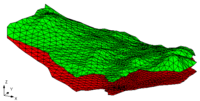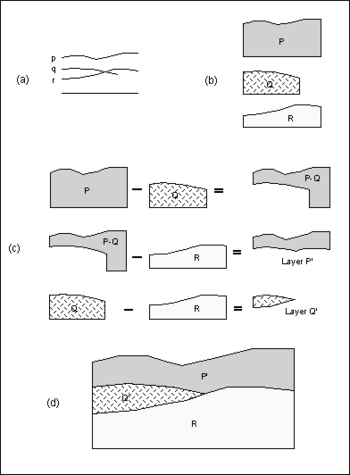GMS:Building Solids and 3D Meshes with TINs: Difference between revisions
From XMS Wiki
Jump to navigationJump to search
No edit summary |
|||
| Line 8: | Line 8: | ||
TINs can be used to build three-dimensional solid models of the soil layers. The transformation from TINs to solids is accomplished using a TIN extrusion and [[GMS:Set Operations|set operation]] procedure illustrated in two dimensions in the following figure. A two-dimensional cross section of three TINs, labeled p, q, and r, is shown in part (a). | TINs can be used to build three-dimensional solid models of the soil layers. The transformation from TINs to solids is accomplished using a TIN extrusion and [[GMS:Set Operations|set operation]] procedure illustrated in two dimensions in the following figure. A two-dimensional cross section of three TINs, labeled p, q, and r, is shown in part (a). | ||
[[Image:stratigmod.png|thumb|none|350 px|The TIN extrusion and set operation process. (a) Sample TINs. (b) Extrusion of surfaces into solids. (c) Creation of layers through set operations. (d) Completed solid model of soil stratigraphy.]] | :[[Image:stratigmod.png|thumb|none|350 px|The TIN extrusion and set operation process. (a) Sample TINs. (b) Extrusion of surfaces into solids. (c) Creation of layers through set operations. (d) Completed solid model of soil stratigraphy.]] | ||
The TINs are converted into temporary solid primitives that represent approximations of the soil layers. The conversion is accomplished by projecting the outer boundary (perimeter) of each TIN down to a horizontal plane. This can be thought of as an extrusion process where a two-dimensional surface is extruded into a three-dimensional solid. A three-dimensional illustration of this process is shown in the figure below. | The TINs are converted into temporary solid primitives that represent approximations of the soil layers. The conversion is accomplished by projecting the outer boundary (perimeter) of each TIN down to a horizontal plane. This can be thought of as an extrusion process where a two-dimensional surface is extruded into a three-dimensional solid. A three-dimensional illustration of this process is shown in the figure below. | ||

